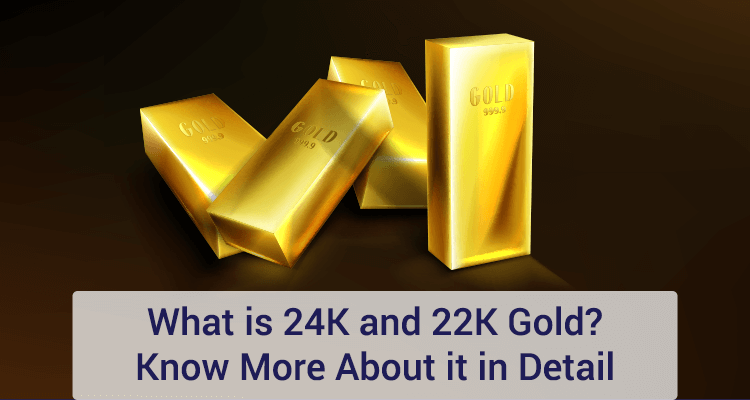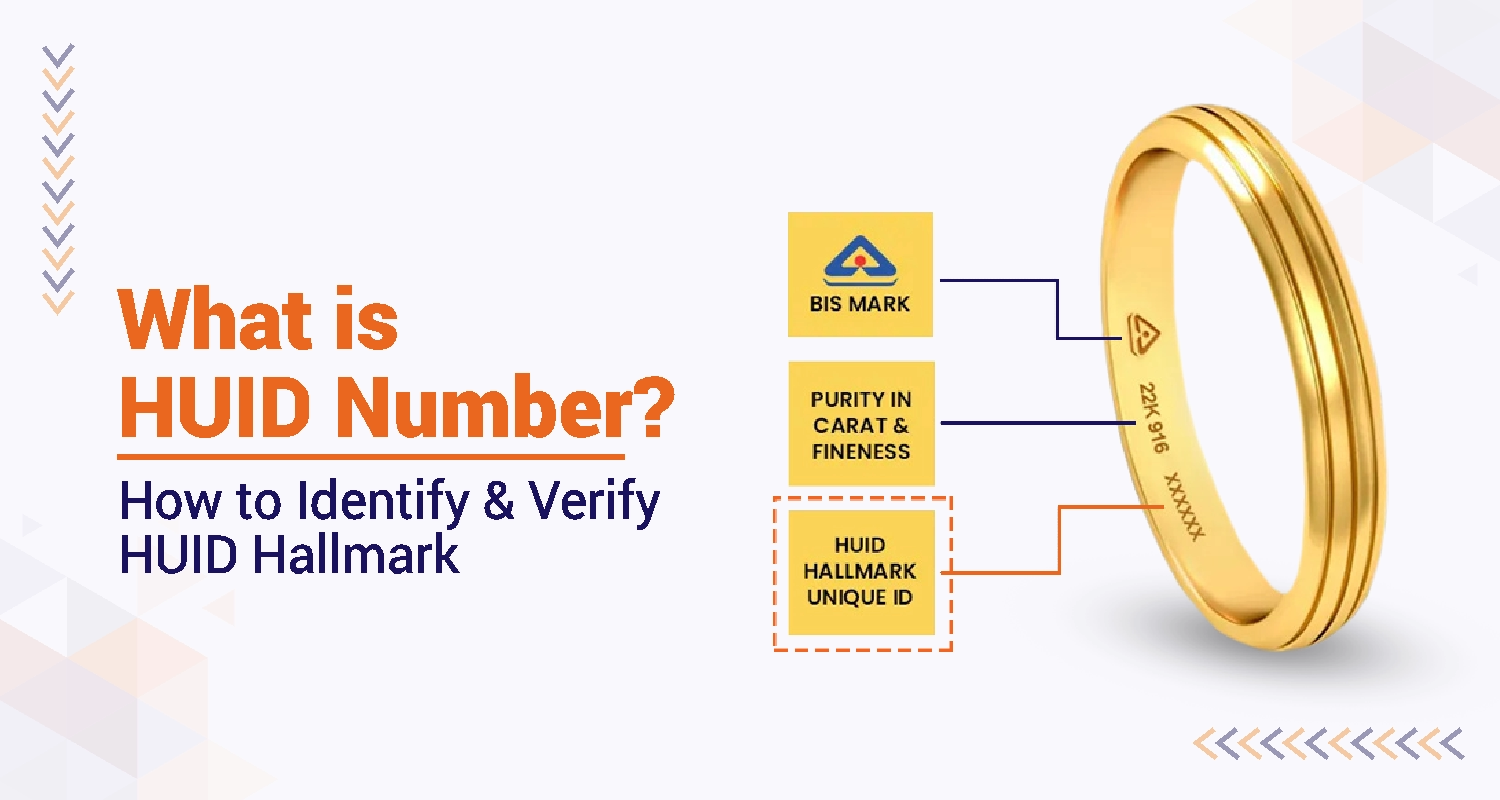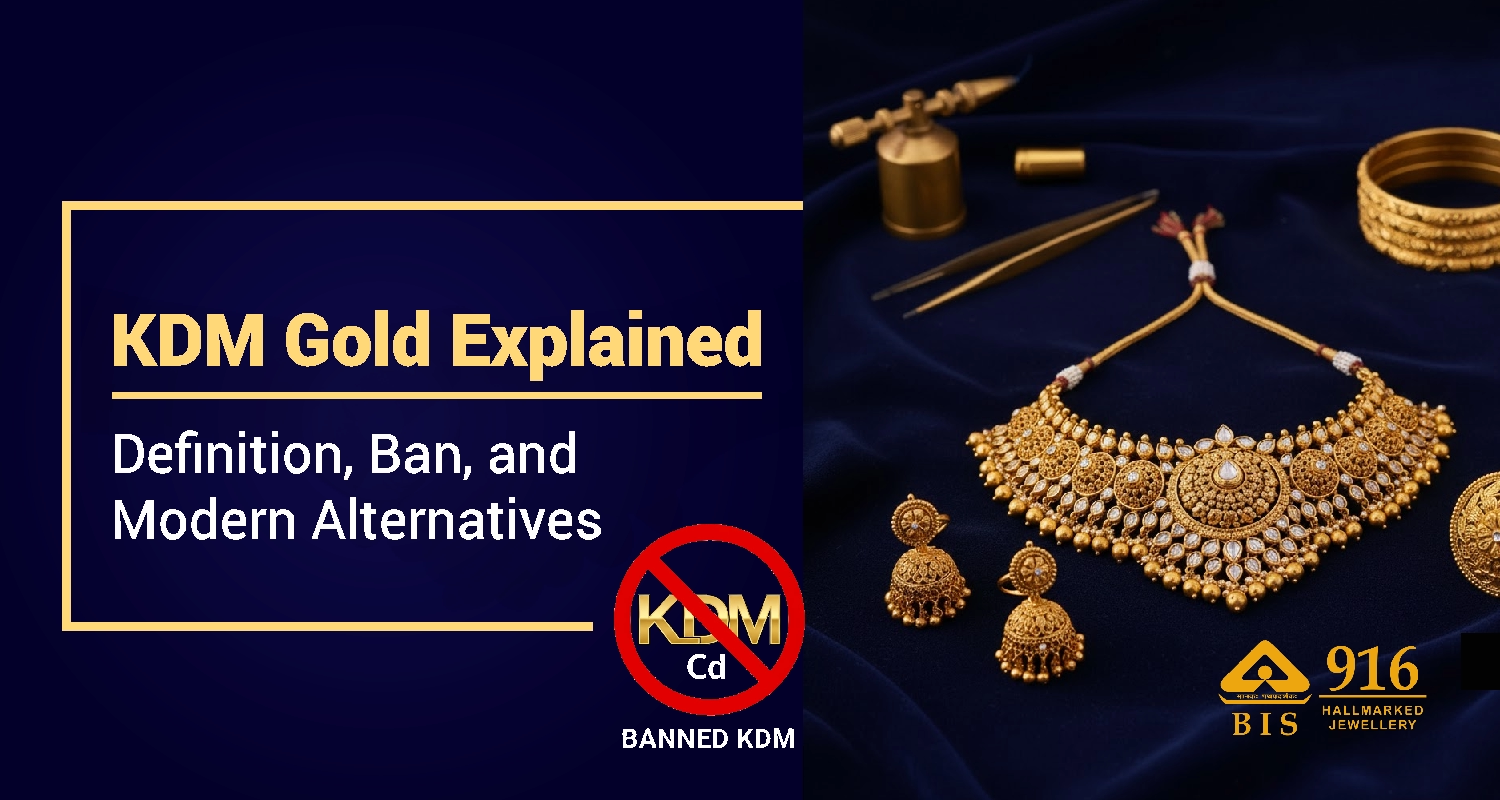22K vs 24K Gold: Purity Percentage, Meaning & Key Differences Explained

The key difference between 22K and 24K gold lies in their purity. 24K gold is 99.9% pure, making it the purest form of gold, while 22K gold contains 91.6% pure gold, with the remaining 8.4% made up of alloy metals like copper or silver for added strength.
In India, where gold holds deep cultural and financial significance, understanding this purity difference is essential when buying or investing in gold. Certified by the Bureau of Indian Standards (BIS) through hallmarking, 22K and 24K gold guarantee authenticity and purity, with 24K being ideal for investment due to its higher intrinsic value.
These hallmarks certify the gold's purity and act as a guarantee of its authenticity. Buying hallmarked gold ensures you get what you pay for and protects you from counterfeit or low-quality gold. The higher the purity, the more expensive the gold. Therefore, when buying gold for investment purposes, it is advisable to choose higher purity gold, such as 24k or 22k, as it carries a higher intrinsic value.
What Does Karat Mean In Gold Quality?
Karat (K) is a unit that measures the purity of gold in items like coins, bars, and jewellery. On the 0-24 karat scale, 24K gold is pure, while lower karats indicate the presence of alloy metals for added strength. Since gold’s purity isn’t visually identifiable, checking its karat value is essential when buying or selling. In India, 22K and 24K gold are the most commonly purchased, making it important to understand the difference between the two before making a purchase.
What Is 22 Karat Gold? Meaning and Purity Percentage
22K gold, also known as 22-karat gold, contains 91.67% pure gold mixed with 8.33% alloy metals like copper, silver, zinc, or nickel to enhance its strength and durability. It is the preferred choice for making jewellery and gold articles due to its balance of purity and durability.
Commonly referred to as 916 gold, 22K gold is more affordable than 24K gold. Its price fluctuates daily, influenced by factors like demand, global market trends, and import duties. Therefore, checking the latest 22K gold price is advisable before making any purchase or sale.
What Is 24 Carat Gold? Meaning and Purity Percentage
24 Karat gold is the purest form of gold available to customers or jewellers in both domestic and international markets. It contains 99.99% gold with no other metals such as copper, nickel, zinc, or silver mixed in.
Gold articles made from 24 Karat gold are of the highest quality and are valued for their purity. However, due to its softness and lack of durability, it is less commonly used for making jewellery. Instead, it finds more applications in electronics, medical equipment, and other specialised uses.
22K vs 24K Gold: Quick Comparison Table
24K gold is the purest and most valuable, its softness makes it impractical for everyday jewellery. On the other hand, 22K gold offers a good balance of purity and strength, making it more suitable for ornaments and regular use.
| Parameter | 22k Gold | 24k Gold |
|---|---|---|
| Purity | 91.67% | 99.9% |
| Composition | Gold + other metals (8.33%) | Almost pure gold |
| Durability | High – suitable for jewellery | Low – not suitable for regular wear |
| Appearance | Slightly darker gold | Bright yellow |
| Use Cases | Jewellery, ornaments | Investment, electronics, medical |
| Price | Lower than 24K | Highest |
| Purpose | Suitable for making jewellery which can be used either for occasions or daily wear | Preferred for investment and specialised industrial applications |
Understanding these differences helps buyers choose the right type of gold based on their needs—whether for jewellery or investment.
Gold Karat and its Purity:
|
Number of Karat |
Gold Purity (%) |
|
24K |
99.9 |
|
22K |
91.7 |
|
18K |
75.0 |
|
14K |
58.3 |
|
12K |
50.0 |
|
10K |
41.7 |
|
9K |
37.5 |
Why is 22K gold preferred over 24K gold?
While both 22 karat (22K) and 24 karat (24K) gold have their own merits, 22K gold is often preferred for certain applications, especially in jewellery, for a few reasons:
- Durability: 22K gold is alloyed with other metals (usually copper or silver) to make it more durable. Pure 24K gold is soft and can be easily scratched or damaged, making it less suitable for everyday wear.
- Colour and Appearance: The alloying process in 22K gold imparts a richer and deeper gold color compared to 24K gold. This can be aesthetically pleasing for jewellery, providing a warm and vibrant appearance.
- Affordability: Since 22K gold contains a lower percentage of pure gold, it is generally more affordable than 24K gold. This can make it a more practical choice for those looking for gold jewellery without the higher cost associated with pure gold.
Ultimately, figuring out what is the difference between 22k and 24k gold and which one to prefer among the two depends on individual tastes, the intended use of the gold (jewellery or investment), and budget considerations.
Which is the Better Investment Option? 24K or 22K?
In terms of investment, the choice between 22 karat (22K) and 24 karat (24K) gold depends on your investment goals and risk tolerance.
24K Gold:
- Purity: 24 karat gold meaning absolutely pure gold, makes it a straightforward investment in the precious metal itself.
- Market Value: The market value of 24K gold is directly linked to the current price of gold in the market.
- Liquidity: Pure gold is highly liquid and can be easily sold or traded globally.
- Long-Term Value: It may be considered a store of value over the long term.
22K Gold:
- Durability: The alloy in 22K gold provides durability, making it more suitable for everyday wear as jewellery.
- Aesthetics: The alloy also gives it a richer gold colour, which some individuals find more visually appealing.
- Market Value: While the market value is still influenced by the price of gold, it may not be as pure and may have additional value based on craftsmanship and design.
- Liquidity: 22K gold is generally liquid but may have additional factors influencing its value beyond the gold content.
Both options can be part of a diversified investment portfolio, but 24K gold might be seen as a more direct and straightforward investment in the metal itself. However, it's crucial to consider factors such as storage costs, market trends, and personal preferences when making investment decisions. Consulting with a financial advisor can provide tailored advice based on your specific financial goals.
How to Verify Authenticity and Purity of 22K and 24K Gold in India
Verifying gold purity in India, while buying gold, is one of the most crucial steps to ensure you get what you pay for. The most reliable way is through BIS (Bureau of Indian Standards) hallmarking, which certifies the purity of gold after a thorough testing procedure. A hallmark of 22K gold or a hallmark of 24K gold acts as proof of authenticity and helps protect buyers from fraud.
Key Ways of Verifying Gold Purity in India:
- Check the BIS Hallmark – Look for the BIS logo along with the karat mark (e.g., 22K916 for 22K gold or 24K999 for 24K gold).
- Verify the Jeweller’s Identification Mark – This is the unique code of the BIS-certified jeweller or manufacturer.
- Check the Assaying & Hallmarking Centre’s Mark – This ensures the gold was tested at an authorised BIS facility.
- Ask for a Purity Certificate – Trusted jewellers provide a certificate mentioning karat, weight, and purchase details.
- Use a Gold Purity Testing Machine – Many jewellers and BIS centres have electronic carat testers for instant verification.
- Density Test - Pure gold has a density of approximately 19.32 g/cc. If there is a noticeable deviation, that means there are other impurities.
- Magnet Test (Basic Screening) - Real gold has no magnetic power. So, if the gold jewellery sticks to a magnet, it indicates that the presence of other metals
- Acid Test - Applying nitric acid to gold reveals its purity. Pure gold won’t react, but impure gold may change color or fizz.
Which Gold is Best for Jewellery in India?
When you are looking to buy the best gold for jewellery in India one of the most crucial factor is to understand the , difference between 22K and 24K gold. 24K gold is considered to be the purest form of gold, containing 99.9% gold. Since it is soft and prone to bending or scratching, it is unsuitable for daily-wear ornaments. However, 22K gold, with 91.67% gold and the rest alloyed with metals like copper or silver, is more durable and retains its shine for years.
Across India, 22K gold is the most preferred choice for, be it bangles, necklaces, or earrings, especially for daily or frequent use. Its hardness ensures that intricate designs hold their shape, while still offering high purity. 24K gold is often chosen for ceremonial pieces, gold coins, and investment purposes, where purity takes precedence over durability.
So, if you are buying jewellery for regular wear, 22K gold is the ideal balance between purity and strength, whereas 24K gold is best reserved for occasions where the focus is on showcasing the highest possible gold purity.
How Purity Affects Gold Jewellery Design and Durability
The purity of 22 carat gold plays a vital role while designing the gold jewellery. It also helps in deciding the durability and practicality of that piece of jewellery. With 91.67% gold content, 22K gold is strong enough to hold intricate patterns and settings. That’s the reason it is the preferred choice for heavy ornaments, daily-wear pieces, and studded jewellery where gemstones need a secure grip. Its slight alloy content improves hardness without significantly compromising on shine.
On the other hand, 24 carat gold purity percentage stands at 99.9%, which makes it too soft and hence it cannot hold gemstones firmly. It is also prone to scratches or deformation, making it unsuitable for daily wear. It is generally used for plain, lightweight ceremonial items or gold coins, where durability is less critical than showcasing maximum purity and value.
So a majority of Indian jewellers often recommend 22K for practical, long-lasting ornaments and reserve 24K for investment or special-occasion pieces.
Price Comparison: 22K vs 24K Gold in the Indian Market
22K gold price India today fluctuates around ₹9,295–9,310 per gram, while 24K gold price India is approximately ₹10,139 per gram in major cities like Delhi, Mumbai, Bengaluru, Pune, and Kolkata
Why the Price Difference?
Purity difference: 22K contains 91.7% gold, so it costs proportionally less than 24K, which is nearly pure (99.9%).
Market dynamics: Physical gold demand, currency rates, and MCX futures all influence the prices of both purities
Sample Price Chart
div class="table-responsive">
| Purity | Rate (₹/gm) | Difference | Notes |
|---|---|---|---|
| 22k | ₹9300 | - | Baseline Price |
| 24K | ₹10,140 | ₹840 | 9% Premium for higher purity |
Current Trends & Outlook
Recent volatility: On August 13, gold prices eased slightly due to USD strength and global economic factors
High watermarks: Earlier this week, 24K touched record highs near ₹10,331/g (Aug 8), while 22K peaked around ₹9,470/g, but both eased thereafter
Investor sentiment: Despite a short dip (~₹1,500 per 10 g for 24K), demand remains strong near the ₹1 lakh/10 g threshold
Avail Of An Ideal Gold Loan With IIFL Finance
With IIFL Gold loan, you get industry-best benefits through our process designed to offer instant funds based on the value of your gold. IIFL Finance Gold Loans come with the lowest fee and charges, making it the most affordable loan scheme available. With a transparent fee structure, there are no hidden costs you have to incur after applying for the loan with IIFL Finance.
Conclusion
Understanding the applications, characteristics and difference between 24 karat and 22 karat gold is essential for making informed decisions, whether for jewellery or investment purposes. While 24K gold purity percentage determines its investment preference, 22K gold emerges as the preferred choice for jewellery, combining durability and aesthetic appeal. Ultimately, the choice between 24K and 22K gold, and the decision to invest in jewellery or pure gold, should be made based on a careful consideration of your personal preferences, budget, and long-term financial goals.
As you explore the world of gold investments, consider the Gold Loan app from IIFL Finance, which provides a convenient and secure platform for managing your gold assets. If you own 22K gold the app offers a streamlined approach to unlocking the value of your gold assets, aligning with your financial objectives.
Get Gold Loan at the comfort of your home
Apply NowFrequently Asked Questions
The gold loan interest rates are between 11.88% - 27% p.a.
Getting a gold loan from IIFL Finance is super easy! Click on the ‘Apply Now’ button mentioned above and fill in all the required details to get a loan approved in few minutes.
The loan tenure for an gold loan is according to the market.
When buying gold jewellery, look for purity in karats, proper weight and hallmarking, Also check for the jeweller's return policy and warranty and proper documentation specifying the gold's purity, weight, and details.
22k gold is used in jewellery as it contains 8.3 per cent mixed alloys, making it stronger and tougher.
22k gold is suitable for daily use as jewellery cannot be made out of 24k gold.
Yes, 9K gold is a good choice for everyday jewellery. While it contains less gold (37.5%) than higher karat options, this makes it more durable for daily wear. The difference between 24k and 22k gold is all about purity. 24k gold is the purest (99%), but too soft for jewellery. 22k gold is 917% gold, a slightly less expensive option with a touch more durability than 24k.
For everyday wear, 14k gold strikes the best balance. It contains 58.3% gold, making it more durable than higher karat options like 18k (75%) and 24k (pure). This added strength allows it to handle daily bumps and scratches better. While 9k (37.5%) is also durable, it has a lower gold content, affecting its shine and colour.
Due to its exceptional purity, 24k gold is very soft and malleable. It scratches and bends easily, making it unsuitable for everyday wear in jewellery.
The addition of other metals in 22k gold enhances its durability. It can withstand daily wear and tear better than 24k gold, making it ideal for crafting beautiful and long-lasting jewellery.
Due to its high purity, 24k gold is primarily used for investment purposes in the form of bars and coins. 22k gold, on the other hand, is the gold standard for crafting beautiful and long-lasting jewellery.
Gold prices are influenced by various external factors, such as the exchange rate of the Indian currency against the US dollar, oil prices, significant political events, and more. Internal factors, including government policies, interest rates, and the demand for gold, also impact gold prices in India.
Karat (K) is a unit that measures the purity of gold in items like coins, bars, and jewellery. On the 0-24 karat scale, 24K gold is pure, while lower karats indicate the presence of alloy metals for added strength. Since gold’s purity isn’t visually identifiable, checking its karat value is essential when buying or selling. In India, 22K and 24K gold are the most commonly purchased, making it important to understand the difference between the two before making a purchase.
You can use the IIFL Finance gold loan calculator to check your loan eligibility for 22K gold jewelry. Simply enter the weight(gm) to see the approximate loan amount you can avail.
Disclaimer : The information in this blog is for general purposes only and may change without notice. It does not constitute legal, tax, or financial advice. Readers should seek professional guidance and make decisions at their own discretion. IIFL Finance is not liable for any reliance on this content. Read more




